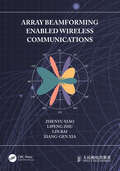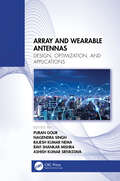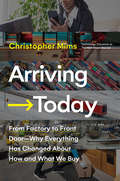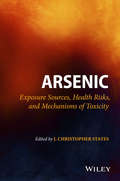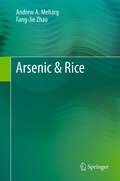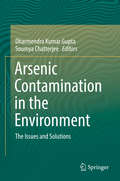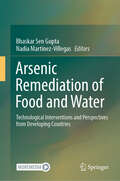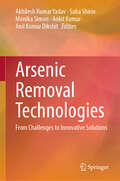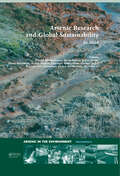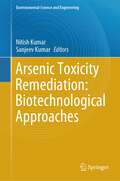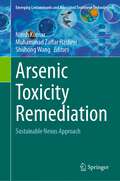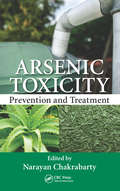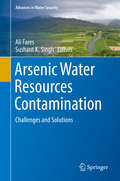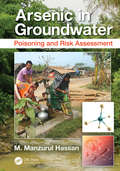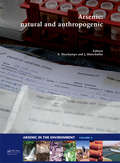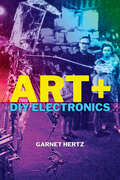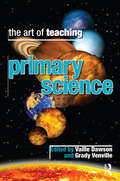- Table View
- List View
Array Beamforming Enabled Wireless Communications
by Lin Bai Zhenyu Xiao Lipeng Zhu Xiang-Gen XiaThis book investigates the most advanced theories and methodologies of array beamforming, with a focus on antenna array enabled wireless communication technology. Combining with the current development needs and trends of wireless communication technology around the world, the authors explore the potentials and challenges of large-scale antenna array beamforming technology in next-generation mobile communication and some important emerging application scenarios. The book first introduces the basic structure of antenna array hierarchical codebook and channel estimation with high dimensionality, with which the time cost of searching the channel information can be effectively reduced. It then explicates high-efficiency beamforming transmission methods for point-to-point transmission, full-duplex point-to-point transmission, and point-to-multipoint transmission where array beamforming enabled non-orthogonal multiple access (NOMA) technologies for typical two-user systems and general multi-user systems are emphasized. The book also discusses array beamforming enabled unmanned aerial vehicle (UAV) communications and array beamforming enabled space/air/ground communications, with the uniqueness and relative solutions for single UAV systems and multi-UAV networks being analyzed. This will be a vital reference for researchers, students, and professionals interested in wireless communications, array beamforming, and millimeter-wave communications.
Array Beamforming with Linear Difference Equations (Springer Topics in Signal Processing #20)
by Jacob Benesty Jingdong Chen Israel CohenThis book studies the link between differential beamforming and differential equations which in turn enables the study of fundamental theory and methods of beamforming from a different perspective, leading to new insights into the problem and new methods to solve the problem. The book first presents a brief overview of the problems and methods for beamforming and some performance measures popularly used either to evaluate beamformers or to derive optimal beamformers. Then, first-order, second-order, and general high-order linear difference equations are discussed, based on which the authors show how to formulate the beamforming problem and derive different beamforming methods, including fixed and adaptive ones. Furthermore, the authors show how to apply the theory of difference equations to the general problem of speech enhancement, and deduce a number of noise reduction filters, including the maximum SNR filter, the Wiener filter, the MVDR filter, etc. Also covered in the book are the difference equations and differential beamforming from the spectral graph perspective.Presents basic concepts, fundamental principles, and methods for beamforming from the perspective of linear difference equations;Provides formulation and methods of conventional beamforming, and first-order, second-order, and general high-order linear difference equations for beamforming;Includes the applications of linear difference equations to the problem of noise reduction;Explains beamforming based on difference equations with graphs.
Array and Wearable Antennas: Design, Optimization, and Applications
by Nagendra Singh Ashish Kumar Srivastava Puran Gour Rajesh Kumar Nema Ravi Shankar MishraThe text highlights the designing of efficient, wearable, and textile antennas for medical and wireless applications. It further discusses antenna design for the Internet of Things, biomedical, and 5G applications. The book presents machine learning and deep learning techniques for antenna design and analysis. It also covers radio frequency, micro-electromechanical systems, and nanoelectromechanical systems devices for smart antenna design.This book: Explores wearable reconfigurable antennas for wireless communication and provide the latest technique in term of its structure, defective ground plane, and fractal design Focuses on current and future technologies related to antenna design, and channel characterization for different communication links, and applications Discusses machine learning techniques for antenna design and analysis Demonstrates how nano patch antenna resonates at multiple frequencies by varying the chemical potential Covers the latest antenna technology for microwave sensors, and for fiber optical sensor communications It is primarily for senior undergraduate, graduate students, and academic researchers in the fields of electrical engineering, electronics and communications engineering.
Arriving Today: From Factory to Front Door -- Why Everything Has Changed About How and What We Buy
by Christopher MimsThe Wall Street Journal technology columnist reveals the fascinating story behind the misleadingly simple phrase shoppers take for granted—“Arriving Today”—in this eye-opening investigation into the new rules of online commerce, transportation, and supply chain management.We are at a tipping point in retail history. While consumers are profiting from the convenience of instant gratification, rapidly advancing technologies are transforming the way goods are transported and displacing workers in ways never before seen.In Arriving Today, Christopher Mims goes deep, far, and wide to uncover how a single product, from creation to delivery, weaves its way from a factory on the other side of the world to our doorstep. He analyzes the evolving technologies and management strategies necessary to keep the product moving to fulfill consumers’ demand for “arriving today” gratification. Mims reveals a world where the only thing moving faster than goods in an Amazon warehouse is the rate at which an entire industry is being gutted and rebuilt by innovation and mass shifts in human labor practices. He goes behind the scenes to uncover the paradoxes in this shift—into the world’s busiest port, the cabin of an 18-wheeler, and Amazon’s automated warehouses—to explore how the promise of “arriving today” is fulfilled through a balletic dance between humans and machines. The scope of such large-scale innovation and expended energy is equal parts inspiring, enlightening, and horrifying. As he offers a glimpse of our future, Mims asks us to consider the system’s vulnerability and its resilience, and who shoulders the burden, as we hurtle toward a fully automated system—and what it will mean when we are there.
Arsenic
by J. Christopher StatesThis book illustrates the chemistry, toxicology, and health effects of arsenic using novel modeling techniques, case studies, experimental data, and future perspectives.* Covers exposure sources, health risks, and mechanisms of one of the most toxic minerals in the world* Helps readers understand potential health effects of arsenic, using population studies, mammalian and invertebrate models, and pharmacokinetic and toxicokinetic models* Discusses outcomes, epidemiology, real-life examples, and modes of action for arsenic-induced diseases, like lung cancer, diabetes, cardiovascular and pulmonary diseases, and immunotoxicity* Acts as a reference for toxicologists, environmental chemists, and risk assessors and includes up-to-date, novel modeling techniques for scientists* Includes future perspectives on special topics, like extrapolation from experimental models to human exposures, biomarkers for phenotypic anchoring, and pathology of chronic exposure
Arsenic & Rice
by Andrew A. Meharg Fang-Jie ZhaoRice is the staple food for half of the world's population. Consumption of rice is the major exposure route globally to the class one, non-threshold carcinogen inorganic arsenic. This book explains the sources of arsenic to paddy soils and the biogeochemical processes and plant physiological attributes of paddy soil-rice ecosystems that lead to high concentrations of arsenic in rice grain. It presents the global pattern of arsenic concentration and speciation in rice, discusses human exposures to inorganic arsenic from rice and the resulting health risks. It also highlights particular populations that have the highest rice consumptions, which include Southern and South East Asians, weaning babies, gluten intolerance sufferers and those consuming rice milk. The book also presents the information of arsenic concentration and speciation in other major crops and outlines approaches for lowering arsenic in rice grain and in the human diet through agronomic management.
Arsenic Contamination in the Environment: The Issues and Solutions
by Dharmendra Kumar Gupta Soumya ChatterjeeThis book provides an overview to researchers, graduate, and undergraduate students, as well as academicians who are interested in arsenic. It covers human health risks and established cases of human ailments and sheds light on prospective control measures, both biological and physico-chemical. Arsenic (As) is a widely distributed element in the environment having no known useful physiological function in plants or animals. Historically, this metalloid has been known to be used widely as a poison. Effects of arsenic have come to light in the past few decades due to its increasing contamination in several parts of world, with the worst situation being in Bangladesh and West Bengal, India. The worrying issue is the ingestion of arsenic through water and food and associated health risks due to its carcinogenic and neurotoxic nature. The impact of the problem is widespread, and it has led to extensive research on finding both the causes and solutions. These attempts have allowed us to understand the various probable causes of arsenic contamination in the environment, and at the same time, have provided a number of possible solutions. It is reported that more than 200 mineral species contain As. Generally, As binds with iron and sulfur to form arsenopyrite. According to one estimate from the World Health Organization (WHO), contextual levels of As in soil ranges from 1 to 40 mg kg-1. Arsenic toxicity is related to its oxidation state which is present in the medium. As is a protoplastic toxin, due to its consequence on sulphydryl group it interferes in cell enzymes, cell respiration and in mitosis. Exposure of As may occur to humans via several industries, such as refining or smelting of metal ores, microelectronics, wood preservation, battery manufacturing, and also to those who work in power plants that burn arsenic-rich coal.
Arsenic Pollution Control in Nonferrous Metallurgy
by Li-Yuan ChaiThe control of arsenic pollution has attracted worldwide attention, as it is one of the top 20 hazardous substances, and greatly threatens the human health, ecological balance, and industrial development. Arsenic pollution results from natural enrichment and anthropological activities, especially mining and smelting operations. This book introduces arsenic pollution control technologies for aqueous solution and solid wastes produced by the utilization of arsenic-containing materials. It systematically discusses the principles and technologies of arsenic pollution control based on the author’s 16 years of research on arsenic, to help readers gain an understanding of various aspects of arsenic pollution control, including the pollution source distribution of arsenic in typical smelters, arsenic behaviors and pollution control technologies in aqueous solution and solid waste, and clean unitization of arsenic-containing materials.
Arsenic Remediation of Food and Water: Technological Interventions and Perspectives from Developing Countries
by Bhaskar Sen Gupta Nadia Martínez-VillegasThe book provides information on the sources of arsenic contamination of groundwater and their impacts in the first part of the book consisting of 8 chapters. Process developments such as nano-adsorbents for removal of arsenic and other heavy metals are discussed in the second part of the book that comprises of 4 chapters. The third part of the book includes 4 chapters on technological interventions for the removal of arsenic such as indigenous ceramic membranes and Subterranean Arsenic Removal (SAR). The fourth part of the book deals with arsenic contamination in food materials and food chain systems, and consists of 5 chapters. Arsenic has long been associated with a variety of health complications in the human body. In order to address this, a chapter on arsenic contamination and impacts on human health has been included in the fifth part of the book. The book would be a valuable reference material for the scientific community in developing countries working on community water supply and treatment, food safety, public health and policy.
Arsenic Removal Technologies: From Challenges to Innovative Solutions
by Ankit Kumar Anil Kumar Dikshit Monika Simon Akhilesh Kumar Yadav Saba ShirinThis book tackles the critical issue of arsenic contamination in water resources, a significant global threat impacting both developed and developing nations. Arsenic exposure poses severe health risks, including cancer, necessitating innovative solutions that prioritize both effectiveness and environmental responsibility. This book explores the diverse sources of arsenic contamination, from naturally occurring minerals to industrial pollutants, and the severe health impacts of chronic exposure, including cancer and cardiovascular diseases. It also covers the latest advancements in bioremediation and nanotechnology, featuring cutting-edge sustainable arsenic removal technologies that go beyond traditional methods like coagulation and filtration. Divided into 14 chapters, the book addresses topics such as bioremediation using microorganisms and natural plant-based systems, integrated bioremediation technologies, and the application of nanotechnology for enhanced efficiency and affordability. It also outlines the development and use of low-cost adsorptive materials and sustainable adsorbents, providing a comprehensive overview of their strengths, limitations, and future prospects. With a focus on both developed and developing countries, the book examines the current state of arsenic removal methods, the challenges faced, and the innovative solutions being developed. It highlights the importance of building capacity and knowledge sharing for sustainable arsenic management. This book is an essential resource for researchers, environmental scientists, engineers, and policymakers working in the fields of environmental science, water treatment, and public health. It equips readers with a detailed and up-to-date perspective on the technologies and strategies needed to effectively mitigate arsenic pollution.
Arsenic Research and Global Sustainability: Proceedings of the Sixth International Congress on Arsenic in the Environment (As2016), June 19-23, 2016, Stockholm, Sweden (Arsenic in the Environment - Proceedings)
by Jochen Bundschuh Prosun Bhattacharya Arslan Ahmad Ravi Naidu Marie Vahter Jerker Jarsjö Jurate Kumpiene Charlotte Sparrenbom Gunnar Jacks Marinus Eric DonselaarThe Congress "Arsenic in the Environment" offers an international, multi- and interdisciplinary discussion platform for research and innovation aimed towards a holistic solution to the problem posed by the environmental toxin arsenic, with considerable societal impact. The congress has focused on cutting edge and breakthrough research in physical, chemical, toxicological, medical, agricultural and other specific issues on arsenic across a broader environmental realm. The Congress "Arsenic in the Environment" was first organized in Mexico City (As2006) followed by As2008 in Valencia, Spain, As2010 in Tainan, Taiwan, As2012 in Cairns, Australia and As2014 in Buenos Aires, Argentina. The 6th International Congress As2016 was held June 19-23, 2016 in Stockholm, Sweden and was entitled Arsenic Research and Global Sustainability. The Congress addressed the broader context of arsenic research along the following themes:Theme 1: Arsenic in Environmental Matrices and Interactions (Air, Water, Soil and Biological Matrices)Theme 2: Arsenic in Food ChainTheme 3: Arsenic and HealthTheme 4: Clean Water Technology for Control of ArsenicTheme 5: Societal issues, Policy Studies, Mitigation and ManagementLong term exposure to low-to-medium levels of arsenic via contaminated food and drinking water can have a serious impact on human health and globally, more than 100 million people are at risk. Since the end of the 20th century, arsenic in drinking water (mainly groundwater) has emerged as a global health concern. In the past decade, the presence of arsenic in plant foods – especially rice – has gained increasing attention. In the Nordic countries in particular, the use of water-soluble inorganic arsenic chemicals (e.g. chromated copper arsenate, CCA) as wood preservatives and the mining of sulfidic ores have been flagged as health concern. The issue has been accentuated by discoveries of naturally occurring arsenic in groundwater, primarily in the private wells, in parts of the Fennoscandian Shield and in sedimentary formations, with potentially detrimental effects on public health. Sweden has been at the forefront of research on the health effects of arsenic, technological solutions for arsenic removal, and sustainable mitigation measures for developing countries. Hosting this Congress in Sweden was also relevant because historically Sweden has been one of the leading producer of As2O3 and its emission from the smelting industries in northern Sweden and has successfully implemented actions to reduce the industrial emissions of arsenic as well as minimizing the use of materials and products containing arsenic in since 1977. The Congress has gathered professionals involved in different segments of interdisciplinary research in an open forum, and strengthened relations between academia, industry, research laboratories, government agencies and the private sector to share an optimal atmosphere for exchange of knowledge, discoveries and discussions about the problem of arsenic in the environment and catalyze the knowledge generation and innovations at a policy context to achieve the goals for post 2015 Sustainable Development.
Arsenic Toxicity Remediation: Biotechnological Approaches (Environmental Science and Engineering)
by Nitish Kumar Sanjeev KumarArsenic contamination in drinking water and associated adverse outcomes is one of the major health issues in more than 50 countries worldwide. The scenario is getting even more detrimental with increasing number of affected people and newer sites reported from all over the world. Apart from drinking water, the presence of arsenic has been found in various other dietary sources. Threatening the health of millions of people due to arsenic’s toxicity and carcinogenicity, the major routes of arsenic exposure for humans are either through drinking water or crops. This edited volume brings together a diverse group of environmental science, sustainability, and health researchers to address the challenges posed by global mass poisoning caused by arsenic water contamination. The book sheds light on this global environmental issue and proposes solutions to aquatic contamination through multi-disciplinary sustainable approaches and case studies from different parts of world. This book addresses the problem of arsenic by pursuing a holistic approach. It presents the status quo in different parts of the world and provides essential information on food-related arsenic exposure risks for humans and possible preventive and curative measures for tackling arsenic poisoning. The mechanisms of arsenic uptake, translocation, and distribution in plants and grains are also explained. In closing, the book reviews a variety of prospective sustainable solutions to the problem of arsenic accumulation in soil and water.The book comprises three sections. First section describes the routes of exposure to environmental arsenic and its transport in soil and aquatic ecosystems including its source and distribution in specific locations. Second section explains the health risks linked to arsenic exposure in food and the environment. Third section addresses sustainable arsenic contamination mitigation strategies using the potential applications of recent biotechnological techniques, bioremediation, phytoremediation, genetic engineering, nanotechnology, and in silico approaches.The book is intended for a broad audience including researchers, scientists, and readers with diverse backgrounds including agriculture, environmental science, food science, environmental management, and human health. It can also be used as an important reference guide for undergraduate and graduate students, university faculties, and environmentalists. The book may serve as a reference to environment and sustainability researchers, students, and policy makers.
Arsenic Toxicity Remediation: Sustainable Nexus Approach (Emerging Contaminants and Associated Treatment Technologies)
by Nitish Kumar Muhammad Zaffar Hashmi Shuhong WangArsenic contamination in drinking water and crops is a major health issue in many countries worldwide, threatening the health of millions of people due to arsenic’s toxicity and carcinogenicity. This edited volume brings together a diverse group of environmental science, sustainability and health researchers to address the challenges posed by arsenic contamination. The book sheds light on this global environmental issue and proposes solutions to aquatic contamination through multi-disciplinary sustainable approaches and case studies from different parts of the world. The chapters contained here present the status quo in different parts of the world and provide essential information on arsenic exposure risks for humans as well as possible measures for tackling arsenic poisoning. The mechanisms of arsenic uptake, translocation and distribution in plants and grains are also explained. In closing, the book reviews a variety of prospective sustainable solutions to the problem of arsenic accumulation in soil and water. The book is comprised of three sections. The first section describes the routes of exposure to environmental arsenic and its transport in soil and aquatic ecosystems. The second section explains the health risks linked to arsenic exposure in food and the environment. The third section addresses sustainable arsenic contamination mitigation strategies using the potential applications of recent biological technology such as biotechnology, bioremediation, phytoremediation, biochar, absorbent, genetic engineering, and nanotechnology approaches. The book is intended for a broad audience including researchers, scientists, and readers with diverse backgrounds.
Arsenic Toxicity: Challenges and Solutions
by Nitish KumarArsenic (As) is a widely distributed element in the environment having no known useful physiological function in plants or animals. Historically, this metalloid has been known to be used widely as a poison. Effects of arsenic have come to light in the past few decades due to its increasing contamination in several parts of world, with the worst situation being in Bangladesh and West Bengal in India. This edited volume brings together diverse group of environmental science, sustainability and health researchers to address the challenges posed by global mass poisoning caused by arsenic water contamination. The book covers sources of arsenic contamination, and its impact on human health and on prospective remediation both by bioremediation and phytoremediation. Applications of advance techniques such as genetic engineering and nanotechnology are also discussed to resolve the issue of arsenic contamination in ground water and river basins. The book sheds light on this global environmental issue, and proposes solutions to remove contamination through a multi-disciplinary lens and case studies from Bangladesh and India. The book may serve as a reference to environment and sustainability researchers, students and policy makers. It delivers an outline to graduate, undergraduate students and researchers, as well as academicians who are working on arsenic toxicity with respect to remediation and health issues.
Arsenic Toxicity: Prevention and Treatment
by Narayan ChakrabartyThe most talked about metalloid in the modern world, arsenic affects the liver, kidney, and lungs; leads to cardiovascular diseases, cancer, and diabetes; and may cause blindness with long-time exposure. With naturally occurring arsenic boosted by mining and other industrial processes contaminating soil and drinking water, arsenic toxicity is a maj
Arsenic Water Resources Contamination: Challenges and Solutions (Advances in Water Security)
by Ali Fares Sushant K. SinghThis edited volume brings together a diverse group of environmental science, sustainability and health researchers to address the challenges posed by global mass poisoning caused by arsenic water contamination. The book sheds light on this global environmental issue, and proposes solutions to aquatic contamination through a multi-disciplinary lens and case studies from Bangladesh and India. The book may serve as a reference to environment and sustainability researchers, students and policy makers.Part one of the book describes the issue of arsenic contamination in ground water and river basins, including its source and distribution in specific locations in India. Part two explains the routes of exposure to environmental arsenic, its transport in aquatic ecosystems, and the health risks linked to arsenic exposure in food and the environment. Part three addresses sustainable arsenic contamination mitigation strategies and policies, the socioeconomic, demographic, cultural and psychological aspects of arsenic contamination, and the potential applications of GIS and remote sensing in providing solutions. Part four concludes by discussing the role of local and regional institutions in water resources management for a variety of issues including but not limited to arsenic contamination, and presents a case study in the Indus river basin in Pakistan to propose future contamination mitigation strategies.
Arsenic in Drinking Water and Food
by Sudhakar SrivastavaArsenic contamination poses a major environmental problem, especially in Southeast Asian countries like Bangladesh and India. Threatening the health of millions of people due to arsenic’s toxicity and carcinogenicity, the major routes of arsenic exposure for humans are either through drinking water or crops. Rice is the crop most affected by arsenic owing to its cultivation in major arsenic contaminated areas, biogeochemical factors in the soil during rice growth, and specific features of rice that enable it take up more arsenic than other crop plants. This book addresses the problem of arsenic by pursuing a holistic approach. It presents the status quo in different parts of the world (North and South America, Europe, Asia, etc.) and provides essential information on food-related arsenic exposure risks for humans, and possible preventive and curative measures for tackling arsenic poisoning. It covers the arsenic contamination status of rice, rice-based products, other vegetables, fishes, mushrooms, and other foods, with a special focus on rice-arsenic interactions. The mechanisms of arsenic uptake, translocation and distribution in plants and grains are also explained. In closing, the book reviews a variety of prospective agronomic and biotechnological solutions to the problem of arsenic accumulation in rice grains. The book is intended for a broad audience including researchers, scientists, and readers with diverse backgrounds including agriculture, environmental science, food science, environmental management, and human health. It can also be used as an important reference guide for undergraduate and graduate students, university faculties, and environmentalists.
Arsenic in Geosphere and Human Diseases; Arsenic 2010: Proceedings of the Third International Congress on Arsenic in the Environment (As-2010) (Arsenic in the Environment - Proceedings)
by Jochen Bundschuh Prosun Bhattacharya Jiin-Shuh JeanThe congress "Arsenic in the Environment" offers an international, multi- and interdisciplinary discussion platform for arsenic research aimed at short-term solutions of problems with considerable social impact, rather than only focusing on cutting edge and breakthrough research in physical, chemical, toxicological, medical and other specific issue
Arsenic in Groundwater: Poisoning and Risk Assessment
by M. Manzurul HassanArsenic-contaminated groundwater is considered one of the world’s largest environmental health crises, as more than 300 million people in more than one-third of countries worldwide are at risk of groundwater arsenic poisoning. This book addresses how arsenic in groundwater impacts human health by using the frameworks of natural sciences, social sciences, and health sciences in the context set by environmental and legal considerations. Arsenic in Groundwater: Poisoning and Risk Assessment examines the spatial, quantitative, and qualitative aspects on arsenic poisoning; for instance, using geographical information systems (GIS) to investigate the spatial discontinuity of arsenic-laced water in spatial and temporal dimensions to uncover patterns of variations over scales from meters to kilometers. Spatial risk mapping provides insight for academics, researchers, policy makers, and politicians on possible long-term strategies for arsenic mitigation. Qualitative methodological approaches uncover the hidden issues of arsenic poisoning on human health and the related social implications. The book also examines legal aspects, such as the right to safe drinking water, as well as an in-depth look at how community participation can shape public policy. Features: Describes arsenic poisoning from both the scientific and social science perspectives Includes technical insights drawn from GIS-based modeling for spatial arsenic discontinuity and spatial health risks of arsenic poisoning Provides a state-of-the-art review of the human health literature and cutting-edge scientific evidence for arsenic-related health and social implications Examines the environmental justice and legal issues of drinking water and its quality Presents environmental policy and public mitigation strategies with Public Participation GIS (PPGIS) related to arsenic contamination More than 2,000 references serve as valuable resources for various aspects of arsenic poisoning
Arsenic in the Environment: Proceedings of the 8th International Congress and Exhibition on Arsenic in the Environment (As2021), June 7-9, 2021, Wageningen, The Netherlands (Arsenic in the Environment - Proceedings)
by Dragan Savic Jochen Bundschuh Prosun Bhattacharya Arslan Ahmad Ravi Naidu Branislav Petrusevski Jan Weijma Erwin Beerendonk van der Wal, Albert van der Wens, PatrickThe Congress and Exhibition Series "Arsenic in the Environment" offers an international, multi- and interdisciplinary discussion platform for research and innovation aimed towards a holistic solution to the challenges posed by the environmental toxin arsenic, with global societal impact. The Congress has focused on cutting edge and breakthrough research in physical, chemical, toxicological, medical, agricultural and other specific issues on arsenic across a broader environmental realm. The Biennial Congress and Exhibition "Arsenic in the Environment" was first organized in Mexico City (As2006) followed by As2008 in Valencia (Spain), As2010 in Tainan (Chinese Taiwan), As2012 in Cairns (Australia), As2014 in Buenos Aires (Argentina), As2016 in Stockholm (Sweden) and As2018 in Beijing (P.R. China).The 8th International Congress As2020 was held June 7-9, 2021 (first time digitally owing to the global COVID-19 pandemic, in Wageningen, The Netherlands) and with a title Arsenic in the Environment - Bridging Science to Practice for Sustainable Development. The Congress addressed the broader context of arsenic research aligned on the following themes:Theme 1: Arsenic in Natural Soil and Water SystemsTheme 2: Arsenic in Agriculture and Food ProductionTheme 3: Health Impacts of ArsenicTheme 4: Technologies for Arsenic Removal from WaterTheme 5: Sustainable Mitigation and Management for Sustainable DevelopmentArsenic in drinking water and food is a major health issue, affecting millions of people in many parts of the world. In recent years serious cases of arsenic exposure through different environmental matrices have been reported from, for example, Argentina, Bangladesh, Chile, China, Taiwan, Turkey, India, Mexico, UK, USA, Pakistan, Vietnam as well as other regions in the world. Arsenic can cause a number of carcinogenic and non-carcinogenic adverse effects on human health and therefore human exposure to arsenic should be avoided. Notably, The Netherlands has been in the forefront of research on arsenic removal technology and developed a cutting edge innovation to remove arsenic to levels below the WHO drinking water guideline to as low as less than 1 μg/L. This has created an enabling environment to discuss on policy issues for defining the new drinking water guideline. The Congress has attracted professionals involved in different segments of interdisciplinary research on arsenic in an open forum, and strengthened relations between academia, research institutions, government and non-governmental agencies, industries, and civil society organizations to share an optimal ambience for exchange of knowledge.
Arsenic: Natural and Anthropogenic (Arsenic in the environment)
by Jörg Matschullat Eleonora DeschampsThe discussion on arsenic in the environment is complex and must grasp the importance of very many, mostly unrelated works on individual aspects. This volume represents one of the first comprehensive and interdisciplinary examinations into arsenic's behaviour in air, water, soils, sediments, plants and the human body. Based on state-of-the-art investigations into the global arsenic cycle, the related human toxicology and available remediation technologies, arsenic is assessed holistically in all the environmental compartments. Using the results of primary research, the authors offer concrete suggestions for risk reduction and management of environmental pollution that allow the reader to successfully tackle similar problems and find sustainable solutions.
Art + DIY Electronics
by Garnet HertzA systematic theory of DIY electronic culture, drawn from a century of artists who have independently built creative technologies.Since the rise of Arduino and 3D printing in the mid-2000s, do-it-yourself approaches to the creative exploration of technology have surged in popularity. But the maker movement is not new: it is a historically significant practice in contemporary art and design. This book documents, tracks, and identifies a hundred years of innovative DIY technology practices, illustrating how the maker movement is a continuation of a long-standing creative electronic subculture. Through this comprehensive exploration, Garnet Hertz develops a theory and language of creative DIY electronics, drawing from diverse examples of contemporary art, including work from renowned electronic artists such as Nam June Paik and such art collectives as Survival Research Laboratories and the Barbie Liberation Front. Hertz uncovers the defining elements of electronic DIY culture, which often works with limited resources to bring new life to obsolete objects while engaging in a critical dialogue with consumer capitalism. Whether hacking blackboxed technologies or deploying culture jamming techniques to critique commercial labor practices or gender norms, the artists have found creative ways to make personal and political statements through creative technologies. The wide range of innovative works and practices profiled in Art + DIY Electronics form a general framework for DIY culture and help inspire readers to get creative with their own adaptations, fabrications, and reimaginations of everyday technologies.
Art of Digital Audio
by John WatkinsonDescribed as "the most comprehensive book on digital audio to date", it is widely acclaimed as an industry "bible". Covering the very latest developments in digital audio technology, it provides an thorough introduction to the theory as well as acting as an authoritative and comprehensive professional reference source. Everything you need is here from the fundamental principles to the latest applications, written in an award-winning style with clear explanations from first principles. New material covered includes internet audio, PC audio technology, DVD, MPEG audio compression, digital audio broadcasting and audio networks.Whether you are in the field of audio engineering, sound recording, music technology, broadcasting and communications media or audio design and installation, this book has it all. Written by a leading international audio specialist, who conducts professional seminars and workshops around the world, the book has been road tested for many years by professional seminar attendees and students to ensure their needs are taken into account, and all the right information is covered.This new edition now includes:Internet audioPC Audio technologyDVDMPEG Audio compressionDigital Audio BroadcastingAudio networksDigital audio professionals will find everything they need here, from the fundamental principles to the latest applications, written in an award-winning style with clear explanations from first principles.John Watkinson is an international consultant in audio, video and data recording. He is a Fellow of the AES, a member of the British Computer Society and a chartered information systems practitioner. He presents lectures, seminars, conference papers and training courses worldwide. He is the author of many other Focal Press books, including: the Kraszna-Krausz award winning MPEG-2; The Art of Digital Audio; An Introduction to Digital Video; The Art of Sound Reproduction; An Introduction to Digital Audio; TV Fundamentals and Audio for Television. He is also co-author, with Francis Rumsey, of The Digital Interface Handbook, and contributor to the Loudspeaker and Headphone Handbook, 3rd edition.
Art of Sound: Creativity in Film Sound and Electroacoustic Music (Sound Design)
by Andrew Knight-Hill Emma MargetsonBringing together a diverse group of world leading professionals across Post-Production Film Sound and Electroacoustic Music, Art of Sound explores the creative principles that underpin how sonic practitioners act to compose, tell stories, make us feel, and communicate via sound. Revealing new understandings through analysis of interdisciplinary exchanges and interviews, this book investigates questions of aesthetics, perception, and interpretation, unveiling opportunities for a greater appreciation of the artistry in sound practice which underpins both experimental electronic music and the world’s leading film and television productions. It argues that we can better understand and appreciate the creative act if we regard it as a constantly unfolding process of inspiration, material action, and reflection. In contrast to traditional notions, which imagine outputs as developed to reflect a preconceived creative vision, our approach recognises that the output is always emerging as the practitioner flows with their materials in search of their solution, constantly negotiating the rich networks of potential. This enables us to better celebrate the reality of the creative process, de-centring technologies and universal rules, and potentially opening up the ways in which we think about sonic practices to embrace more diverse ideas and approaches. Art of Sound provides insight into the latest developments and approaches to sound and image practice for composers, filmmakers, directors, scholars, producers, sound designers, sound editors, sound mixers, and students who are interested in understanding the creative potential of sound.
Art of Teaching Primary Science
by Grady Venville Vaille DawsonChildren have an innate curiosity about the natural world that makes teaching science a rewarding experience.However teaching science is an art that requires a unique combination of knowledge and skills to make the most of students' interest and foster their understanding. With contributions from leading educators, The Art of Teaching Primary Science addresses the fundamental issues in teaching science in primary and early childhood years.Reflecting current research in science education, The Art of Teaching Primary Science covers the following areas:* the theoretical underpinnings of science education and curriculum;* effective science teaching practice planning, teaching strategies, investigations, resources and assessment;* key issues including scientific literacy, integrating science and technology, and activities outside the classroom.The Art of Teaching Primary Science is invaluable for student teachers as a guide to the fundamentals of science education, and as a resource for experienced teachers to review and enhance their professional skills.'An excellent reference for those teachers of the primary years seeking the best ways to engage their students in good science and scientific investigation, and keen to link these with other learning areas.'Peter Turnbull, President, Australian Science Teachers Association
